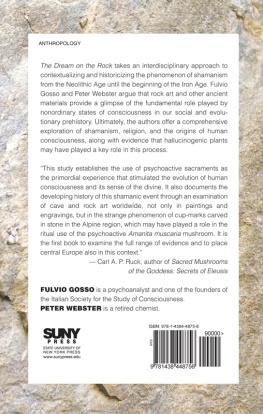Webster Peter - The Dream on the Rock: Visions of Prehistory
Here you can read online Webster Peter - The Dream on the Rock: Visions of Prehistory full text of the book (entire story) in english for free. Download pdf and epub, get meaning, cover and reviews about this ebook. year: 2013, publisher: State University of New York Press, genre: Romance novel. Description of the work, (preface) as well as reviews are available. Best literature library LitArk.com created for fans of good reading and offers a wide selection of genres:
Romance novel
Science fiction
Adventure
Detective
Science
History
Home and family
Prose
Art
Politics
Computer
Non-fiction
Religion
Business
Children
Humor
Choose a favorite category and find really read worthwhile books. Enjoy immersion in the world of imagination, feel the emotions of the characters or learn something new for yourself, make an fascinating discovery.
- Book:The Dream on the Rock: Visions of Prehistory
- Author:
- Publisher:State University of New York Press
- Genre:
- Year:2013
- Rating:5 / 5
- Favourites:Add to favourites
- Your mark:
- 100
- 1
- 2
- 3
- 4
- 5
The Dream on the Rock: Visions of Prehistory: summary, description and annotation
We offer to read an annotation, description, summary or preface (depends on what the author of the book "The Dream on the Rock: Visions of Prehistory" wrote himself). If you haven't found the necessary information about the book — write in the comments, we will try to find it.
The Dream on the Rock: Visions of Prehistory — read online for free the complete book (whole text) full work
Below is the text of the book, divided by pages. System saving the place of the last page read, allows you to conveniently read the book "The Dream on the Rock: Visions of Prehistory" online for free, without having to search again every time where you left off. Put a bookmark, and you can go to the page where you finished reading at any time.
Font size:
Interval:
Bookmark:

T HE D REAM ON THE
ROCK
T HE D REAM ON THE
ROCK
visions of prehistory
Fulvio Gosso
and
Peter Webster

Published by State University of New York Press, Albany
2013 State University of New York
Il Sogno Sulla RocciaVisioni dalla Preistoria 2011 Edizioni Altravista
All rights reserved
Printed in the United States of America
No part of this book may be used or reproduced in any manner whatsoever without written permission. No part of this book may be stored in a retrieval system or transmitted in any form or by any means including electronic, electrostatic, magnetic tape, mechanical, photocopying, recording, or otherwise without the prior permission in writing of the publisher.
For information, contact State University of New York Press, Albany, NY
www.sunypress.edu
Production by Eileen Nizer
Marketing by Michael Campochiaro
Library of Congress Cataloging-in-Publication Data
Gosso, Fulvio,
[Il sogno sulla roccia English]
The dream on the rock : visions of prehistory / Fulvio Gosso and Peter Webster.
pages cm
Includes bibliographical references and index.
Summary: Examines the relationship between rock art, shamanism, and the origins of human existenceProvided by publisher.
ISBN 978-1-4384-4875-6 (hardcover : alk. paper)
1. Petroglyphs. 2. Rock paintings. 3. Art, Prehistoric. 4. Shamanism in art. I. Title.
GN799.P4G6645 2013
709.01'13dc23
2013000109
10 9 8 7 6 5 4 3 2 1
If it were clear that madness is evil, that would suffice.
Yet mankind receives the greatest of good things
Precisely as a result of that state of delirium given as a divine gift.
Thus the Delphic prophetess and the priestesses at Dodona,
When they are seized by mania do Greece many good things,
Both for the public and for individuals.
But when they are possessed of normal sanity, they do little or nothing.
Plato, Phaedrus 224ab
Contents
1
Foundations of the Research
2
Sites of the Research
3
The Significance of the Research
4
Origins of Psychedelia (Peter Webster)
List of Tables and Illustrations
Acknowledgments
The Dream on the Rock was originally published in Italian as Il Sogno Sulla Roccia Visioni dalla Preistoria by Edizioni Altravista in 2011.
Our sincere thanks to our good friends Gianluca, Erika, and Sharon for their invaluable assistance in preparing the translation from the Italian.
Introduction
The ancient world of gods and demigods is for us difficult to imagine. Even the appalling living conditions of prehistory are beyond our comprehension. Yet in those dark and mysterious times lived the first experts in modified states of consciousness, the perhaps inaptly-named shamans, so important to all the ancient tribes of man.
We say inaptly because, strictly speaking, as Mircea Eliade tells us, these persons were at one and the same time the sorcerer, the healer, the priest: Now, shamanism is precisely one of the archaic techniques of ecstasyat once mysticism, magic, and religion in the broadest sense of the term. Shamanism was, par excellence, a religious phenomenon in Siberia and Central Asia. The word comes down to us through the Russian, Tungus shaman.
The first information on the practices of shamanism appeared only at the very end of the European Renaissance, the most reliable reports date back to the early 1700s. Lacking any precise references about the use of Amanita muscaria, however, it is therein implied that the Siberian shaman seemed to reach nonordinary states of consciousness without resorting to psychoactive substances. Rather, strange powers and natural gifts were passed down within the family from generation to generation. Shamanism was merely a transmitted phenomenon, such as the color of eyes or of hair; it was not for everyone to know the secrets. This is the first constant of shamanism.
The transformation of normal to shamanic consciousness is almost always the result of a personal experience of illness and healing, a mental and/or physical illness or traumatic event that evokes an experience of death and rebirth. This second constant characteristic is well known even in contemporary societythough little usedwhen the sick man who is healed and thus knows himself is able to heal in turn.
A further constant of shamanism, characteristic of other times and other places, is the union of reality and dream, of matter and spirit, a synthesis of the daily event and the inexplicable event. Concerning the importance of meaning there are no boundaries. It is, rather, the vision, the spiritual context that is prevalent and which provides guidance on making personal and collective choices.
The shaman is also a consummate and astute actor, always over the top, flamboyant, gaudy and noisy, masked, painted, strangely pompous, overblown and moody, an actor capable of playing multiple roles, catching the attention as would a magician. And sometimes maybe it is merely showmanship, yet at root the show is in truth like a modern psychodrama. Undoubtedly, the shaman is of the trickster archetype, the divine prankster, enjoying an awareness of the Self and others which enables modification of the Self. The shamanic practice: a circumventing of the rational, of necessity employing deception, but with good intentions.
To summarize briefly, whether shamanism is manifested through inheritance, or augmented by natural or innate ability, it is universally born from a spiritual vision, the call, which is almost an obligation to respond. The rite of passage that becomes manifest is, however, always a psychological event of death and rebirth of the Self, the Ego. It requires a cultural context that accepts and integrates the shamanic event, that supports the shamans power to interact and respond to lifes theatre of events.
The shamans methods work across the board on the sensory-motor apparatus, and the auditory is particularly important. Often, rhythmically simple sounds are repeated, monotonous themes are performed vocally or with simple wind or string instruments. Long, sing-song, and musically essential: the Carnatic singing of southern India and singing of Sufi Zikr are well-evolved examples, as is the sound of Australian didgeridoo and the music and songs of Moroccos Atlas Mountains or Sbnikoro in Mali.
Almost all so-called ethnic music is shamanicthe genuine article, of course, and not abridged or commercial versions. The principal instrument in this production is the drum, sometimes, as in Siberian tradition, assisted by bells. (In the 1950s such music was forbidden by the Soviet regime in an effort to suppress the shamanic practices of Kamtchatka, practices that did not fit the official conception of genuine socialism.)
Eliade devotes several pages of his book to the role of the drum, the construction of which is in itself a precise ritual. The choice of wood, the leather and its tanning, the methods of assembly nothing is left to chance. The percussion is simple, monotonous, smooth and steady, prolonged, often accompanied by a song with no true melody, story, or the invocation of a song. Dance is not a requirement but often accompanies the sound, even as an almost involuntary rhythmic movement, or as postures that may imitate hunting or the movements of the hunted animal.
The relationship with all of nature, with both plants and animals, is fundamental. One never hears or reads of urban shamans. Instead, the context is universally the vast wilderness, and as German ethnologist Hans Peter Duerr explains, the vastness is not only a physical dimension but also an existential category. Of particular interest is the relationshipalmost fusionwith the animal-guide with which the shaman identifies himself. The identification is complete: the shaman becomes a bear, a wolf, a bird.
Font size:
Interval:
Bookmark:
Similar books «The Dream on the Rock: Visions of Prehistory»
Look at similar books to The Dream on the Rock: Visions of Prehistory. We have selected literature similar in name and meaning in the hope of providing readers with more options to find new, interesting, not yet read works.
Discussion, reviews of the book The Dream on the Rock: Visions of Prehistory and just readers' own opinions. Leave your comments, write what you think about the work, its meaning or the main characters. Specify what exactly you liked and what you didn't like, and why you think so.











